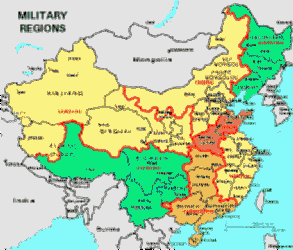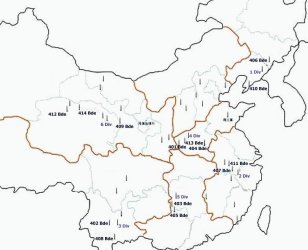





Commander Yang Guoliang
Deputy Commander Li Qianming
Zou Yongzhao
Political Commissar Sui Yongju
Deputy Political - Commissar Cao Heqing
Wang Honghai
China's strategic nuclear force, referred to as the Second Artillery Corps, was established in Beijing on 1 July 1966, and Premier Zhou Enlai personally named it the Second Artillery Corps [SAC]. In the early eighties, China's strategic guided missile force conducted its first large-scale combined battle exercise to examine the force's overall combat capability. The 2d Artillery Corps is under the operational control of the general staff, but is directly controlled by the Central Military Commission, and has been an independent arm of the Chinese armed forces since 1974. It is equipped with hundreds of strategic and tactical missiles of various types.
The Second Artillery Corps is believed to be organized into a headquarters in Qinghe near Beijing, an early warning division, a communication regiment, a security regiment, a technical support regiment, and six ballistic missile Divisions. The Second Artillery headquarters complex consists of headquarters, political, logistics, and equipment technology departments, each headed by a PLA major general.
In addition to these combat formations, the signal unit of the Second Artillery Corps operates communications systems to provide communications support capabilities for launch operations. The headquarters complex maintains contact with subordinate units through its own communications regiment.The Second Artillery also has one engineering design academy and four research institutes to solve problems associated with operations, transporter erector launchers (TELs), and logistics (First Institute), command automation, targeting, and mapping (Third Institute), and missile and warhead engineering design. The Second Artillery�s Command College in Wuhan prepares officers for leadership positions within headquarters elements and launch brigades. The Engineering College in Xian educates technicians.
The Second Artillery, with an estimated 90,000 personnel [some estimates are as high as 120,000], most of which are in engineering and construction units. Actual missile operators and guards are probably less than half of the total strength. According to one estimate the missile troops number some 50,000 persons; the technical-equipped force about 17,000; the construction troops some 20,000; the anti-chemical and communication troops 50,000 for each; the training units: some 10,000 persons, and the logistic support troops some 20,000 persons. This total of some 217,000 is about twice as large as typically reported aggregate troop strengths, and may reflect the assignment of troops from other branches in support of the Second Artillery.


The six Divisions are independently deployed in the main military regions. Each missile Division probably averages around 10,000 troops, with some strength fluctuation based on missile types. The Divisions, comprised of Guided Missile Launched Brigades deployed, are each headed by a major general. Each Division is directly subordinate to the Second Artillery commander in Qinghe, although they do receive support from the military regions. Along with other major formations, a Division is also at times termed a "base" -- which may be somewhat confusing since Division headquarters are not co-located with actual missile bases. A Division headquarters structure mirrors that of the national headquarters in Qinghe with Headquarters, Political, Logistics, and Equipment and Technology Departments. In addition, each Division has training (jiaodaodui) and nuclear warhead (euphemistically referred to special equipment) maintenance units. Each Division has regiment-level special departments (chu) responsible for chemical defense, communications, training, security, and weather, as well as two or three subordinate brigades (lu).
Each Brigade, commanded by a colonel, has up to four launch battalions (fashe ying). Missile brigades are generally structured by type of missiles, with each brigade having only has one type of missile, thus facilitating maintenance and specialization. There were at least 13 Brigades in the Second Artillery in the early 1990s, though by the end of the decade this number had increased to as many as 17 Brigades. This increase in force structure apparently reflected the deployment of additional DF-5 nuclear ICBMs, as well as the deployment of conventional M-9 and M-11 missiles aimed at Taiwan.
Second Artillery Corps Order of Battle ~1999 | ||||||
| Division | Brigade | Province | City | Equipment | ||
| SAC Headquarters | Beijing | Qinghe | ||||
| 80301 Unit / 51 Base | Liaoning | Shenyang | ||||
| 406 Brigade | Tonghua | DF-21 | ||||
| 410 Brigade | Dengshahe | DF-3 | ||||
| UI Brigade | DF-3 | |||||
| 80302 Unit / 52 Base | Jiangxi | Huangshan | ||||
| 407 Brigade | Lianxiwang | DF-3 / DF-21 | ||||
| 411 Brigade | UI Location | |||||
| 815 Brigade | Jiangxi | Leping | DF-15 | |||
| 80303 Unit | Yunnan | Kunming | ||||
| 402 Brigade | Chuxiong | DF-21 | ||||
| 408 Brigade | Jianshui | DF-3 / DF-21 | ||||
| 80304 Unit | Henan | Luoyang | ||||
| 401 Brigade | Luoning | DF-5 | ||||
| 404 Brigade | Sundian | DF-4 | ||||
| 413 Brigade | UI Location | |||||
| 80305 Unit | Hunan | Huaihua | ||||
| 403 Brigade | Dalong | DF-3 | ||||
| 405 Brigade | Tongdao | DF-4 | ||||
| UI Brigade | Tongdao | DF-5 | ||||
| 80306 Unit | Qinghai | Xining | ||||
| 409 Brigade | Datong | DF-3 / DF-21 | ||||
| 412 Brigade | Da Qaidam | DF-4 | ||||
| 414 Brigade | Delingha | DF-4 | ||||
